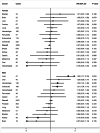Associations of sarcopenia, sarcopenia components and sarcopenic obesity with cancer incidence: A prospective cohort study of 414,094 participants in UK Biobank
- PMID: 40396701
- PMCID: PMC12334911
- DOI: 10.1002/ijc.35480
Associations of sarcopenia, sarcopenia components and sarcopenic obesity with cancer incidence: A prospective cohort study of 414,094 participants in UK Biobank
Abstract
Sarcopenia is characterised by low grip strength, muscle quantity or quality, and physical performance. This study investigated the associations of sarcopenia and its components with cancer incidence. A prospective cohort study was conducted utilising data from the UK Biobank. Sarcopenia and its components were defined according to the European Working Group on Sarcopenia in Older People criteria (EWGSOP2 2019). Cox proportional hazard models adjusted for sociodemographic, lifestyle, and health-related factors were performed. Overall, 63,379 out of 414,094 study participants had an incident diagnosis of cancer during a median follow-up of 11.7 years. In total, 32,286 participants had probable sarcopenia and 934 confirmed/severe sarcopenia at recruitment. Combined probable, confirmed, and severe sarcopenia was associated with a higher risk of liver (hazard ratio [HR] = 1.65, 95% confidence interval [CI]: 1.17-2.33), haematological (HR = 1.22, 95% CI: 1.01-1.46), and colorectal cancer (HR = 1.21, 95% CI: 1.04-1.41) in males, but not in females. The components of sarcopenia were associated with a higher risk of several cancers, including low grip strength (with liver, haematological and colorectal cancer in males), low muscle mass index (oesophageal in females and oral cancer in males), and slow walking pace (liver and lung in males, lung and overall cancer in females). Compared to participants with non-sarcopenic obesity, those with sarcopenic obesity had a higher risk of colorectal cancer in males (HR = 1.31, 95% CI: 1.03-1.68). Our study suggests that sarcopenia, sarcopenia components, and sarcopenic obesity can be associated with risk for several cancers, mainly of the gastrointestinal tract and in males. Thus, early identification of sarcopenia components may benefit cancer prevention.
Keywords: cancer; grip strength; muscle mass; sarcopenia; sarcopenic obesity.
© 2025 The Author(s). International Journal of Cancer published by John Wiley & Sons Ltd on behalf of UICC.
Conflict of interest statement
All authors declare that they have no conflict of interest.
Figures





References
-
- Rosenberg IH. Summary comments. Am J Clin Nutr. 1989;50(5):1231‐1233.
MeSH terms
LinkOut - more resources
Full Text Sources
Medical

